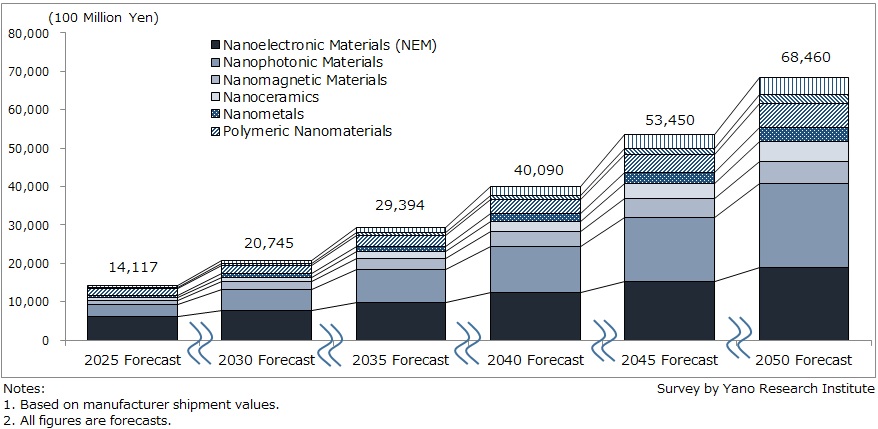No.3785
The Nanoscale Materials Market in Japan: Key Research Findings 2025
Nanoscale Materials Market (Total of Eight Types of Materials) Reached 1,411.7 Billlion Yen in 2025, and Expected to Achieve 6,800.0 Billion Yen by 2050
Yano Research Institute (president, Takashi Mizukoshi) conducted a survey on the nano-level materials market in Japan and abroad. The survey reveals the market trends by material type/segment and market player trends, as well as future outlook. In here highlights the forecast of the size of the domestic nanoscale materials market size through 2050.

Market Overview
Based on the manufacturer shipment values, this research estimates that the market for nanoscale materials (a total of eight types) in Japan to be 1,411.7 billion yen in 2025.
Specifically, nanoelectronic materials (NEMs) account for about 43.0% of the market, followed by nanophotonic materials at about 23.3%. Although electronic devices have reached the ultimate level of miniaturization, the rate of miniaturization is slowing while power consumption is increasing. The primary challenge in manufacturing electronic devices at the nanoscale is to achieve high performance and low power consumption simultaneously.
Noteworthy Topics
Although electronics have become more powerful through miniaturization, they now face the challenge of becoming smaller while reducing power consumption
Various base technologies play different roles in the development of nanotechnology and materials science. For instance, manufacturing technologies such as minute processing and laminate processing (the latter of which involves integrating material processing and molding), enable control and structuring at the nanometer scale.
In addition, high-resolution microscopes and other cutting-edge measurement technologies are essential tools for observing and analyzing at the nanometer scale. Analytical technologies and data science that leverage first-principles calculations, simulations, and modeling are also very important.
Meanwhile, the development of electronics has generated a negative consequence: increased energy consumption. Future developments should improve energy efficiency while maintaining high performance. Realizing sustainable technology requires the development of high energy efficiency devices.
Future Outlook
The nanoscale materials market size in Japan is forecast to reach 6,846.0 billion yen in 2050.
Although developing new nanoscale materials cannot be achieved easily, leveraging AI and machine learning makes it possible to accelerate new material discovery, which will bring about various developments.
Progress in this area could lead to improved performance and a wider range of applications. This includes exploring materials with different physical features and electrical properties. Nanoscale material development has the potential to result in high-performance devices. Therefore, improvements in information processing and communication technologies are anticipated through the development of smaller transistors and faster, and more energy-efficient devices.
Research Outline
2.Research Object: Companies producing, selling, or distributing the target materials, and R&D institutes developing the target materials
3.Research Methogology: Face-to-face interviews by expert researchers (including online)
The Nanoscale Materials Market
Nanoscale materials in this research refer to nanoelectronic materials (NEMs), nanophotonic materials, nanomagnetic materials, nanoceramics, nanometals, polymeric nanomaterials, nanocarbon materials, and nanobiomaterials. The market size has been calculated based on the shipment value.
<Products and Services in the Market>
Nanoelectronic materials (NEMs), nanophotonic materials, nanomagnetic materials, nanoceramics, nanometals, polymeric nanomaterials, nanocarbon materials, and nanobiomaterials.
Published Report
Contact Us
The copyright and all other rights pertaining to this report belong to Yano Research Institute.
Please contact our PR team when quoting the report contents for the purpose other than media coverage.
Depending on the purpose of using our report, we may ask you to present your sentences for confirmation beforehand.